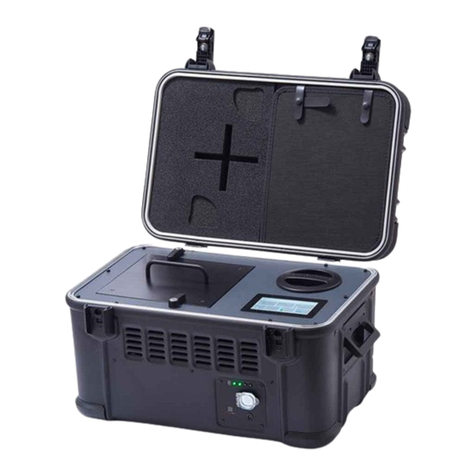
1. SAFEKEEPING OF THE MANUAL
The technical manual belongs to the Cellbox Flight CDI
and must accompany the device at all times. This en-
sures that persons operating the device can refer to the
content of the manual as required.
The latest version of the technical manual can be
opened by scanning the code on the type plate
of the Cellbox or below:
2. DEVICE DESCRIPTION
The Cellbox is an electronic device developed by Cellbox
Solutions GmbH for the safe and documented transport
of living cells. The living cells, which can be transported in
various cell culture vessels, are enclosed within the incu-
bation chamber of a robust transport trunk. This creates a
controlled environment wherein the physical parameters,
such as the temperature and CO2 concentration (to main-
tain the pH value of the medium buffer system) can be
defined and stably maintained for a period of at least 24
hours without an external power source.
In order to achieve the optimal conditions for the
transport of living cells, the Cellbox is able to control the
ambient temperature around the cell culture vessels with
precision. This function is further supported by the con-
tinuous circulation of air around the cell culture vessels,
resulting in an even temperature distribution. The device
also maintains a constant internal CO2concentration by
automatically dispensing pure gaseous CO2. This sus-
tains the vitality of the in vitro cell cultures by providing a
source of environmental CO2that stabilizes the pH. To
ensure that an adequate supply of gaseous CO2 is avail-
able for the entire period of transport, the device has
been fitted with a thermally-insulated container for the
storage of dry ice. Through the process of sublimation
gaseous CO2is produced for the conditioning of the
transport compartment. A complete fill with dry ice can
maintain a 5% CO2environment for up to 24 hours.
The Cellbox can be operated from its built-in rechargea-
ble Lithium-Ion Battery packs, an external power supply
or even an automotive/vehicle power adapter (see chap-
ter 6.1). This provides the user with various options to
ensure an uninterrupted power supply during transport.
Sensors within the transportation compartment of the de-
vice log data of the conditions that the cells (living cargo)
experience during transport. These data logs can easily
be transferred to a mobile device using Bluetooth con-
nectivity to the Cellbox App.
3. INTENDED USE
3.1 Purpose
This device is intended to serve as a protective environ-
ment that can sustain living cells, in various cell culture
vessels, for a defined period of time, with the purpose of
transport. In this context transport can refer to carrying
the device or moving the device with the aid of a vehicle.
When in operation the device can be configured to auto-
matically maintain a set internal temperature and CO2
concentration.
Power can be supplied to the device by means of an
external power supply or in a portable manner from the
internal battery packs.
The following cell culture vessels are compatible with the
Cellbox:
• Multiwell-plates with 6, 12, 24, 48, 96 and 384
wells
• Multiwell-plates with standard ANSI/SBS
footprint.
• Various chip formats
• Various cell culture bags
• Various cell culture flasks
3.2 Restrictions on the Use of this Device
This device is intended for Research Use
Only (RUO).
It is strictly forbidden to use the device for the transport
of infectious substances as classified within Class 6.2
of the ADR (European Agreement concerning the Inter-
national Carriage of Dangerous Goods by Road, appli-
cable as from 01.01.2015) as well as Class 3.6.2 of
the IATA (International Air Transport Association - Dan-
gerous Goods Regulations, applicable as from
01.01.2021).
Use of the device for any purpose other than the in-
tended purpose described in section 3 is classified as
misuse and can result in danger or damage.
The device may not be used for the transport of materials
and substances that could produce toxic vapors or ex-
plosive fumes at the set temperature. Furthermore, mate-
rials and substances that pose a risk of exploding, burst-
ing or igniting may not be transported in this device. If
any doubt arises about the composition of the materials
or substances to be transported, they must not be
loaded in the device.
Potentially explosive gas-air mixtures may not be formed
in the transportation compartment, nor may the device
be operated in their immediate vicinity.




























